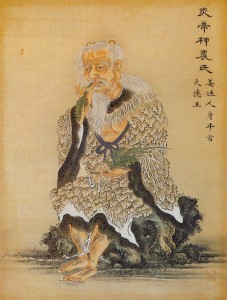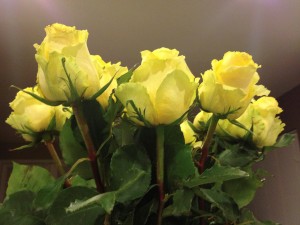With origins dating back 5,000 years, Aromatherapy is truly one of the oldest methods of bringing comfort and balance to a person’s life.
Research has shown that ancient Chinese civilizations were used aromatherapy. The emperor Shen Nong (pictured below) is acknowledged for compiling the first treatise on traditional Chinese herbal medicine, Shen Nong’s Herbal Classic (Shen Nong Ben Cao Jing). It was first compiled sometime during the end of the Western Han Dynasty, lists various medicinal herbs at given grade and rarity ratings. The book recorded 365 types of herbal medicine, some of which are still used in contemporary clinics.
The ancient Chinese also used aromatics in religious ceremonies by burning woods and incense as part of their cultural tradition. The use of aromatics in China was linked to other traditional therapies such as massage. It is believed that aromatherapy was also utilized by ancient Egyptians, who employed the method of infusion to extract the oils from aromatic plants which were used for health care and cosmetic purposes. The Ebers Papyrus is one of the oldest known medicinal works recording one hundred medicinal prescriptions, including essential oils. It dates back to 1550 B.C. and was discovered in 1873 by Egyptologist Ebers. The Nile Valley was known as the Cradle of Medicine; a haven of plants, trees, and small bushes brought from India, Persia, and Syria.
Aromatherapy has also been used for many centuries in India. Ayurveda, the traditional medical system of India, uses dried and fresh herbs, as well as aromatic massage as important aspects of treatment. Essential oils are used in Ayurvedic therapeutic formulations for their ability to help transport the healing wisdom of herbs and herbal oils to the cells and tissues of the body. They play the same important role in transdermal formulations and skincare that spices do in cooked preparations and compound herbal formulations that we take internally.
In Ayurveda, the oils are believed to help create balance through the sense of smell. The rose, for example, is renowned in Ayurveda for its ability to pacify an excitable nature. Lavender helps pacify the mind and nervous system and thus helps promote restful sleep.
The Greeks found that the fragrance of some flowers was stimulating while others had relaxing properties. The use of olive oil as the base oil absorbed the aroma from the herbs or flowers and the perfumed oil was then used for both cosmetic and medicinal purposes.
The Romans were well known for scented baths followed by a massage with aromatic oils. The popularity of aromatics led to the establishment of trade routes which allowed the Romans to import essential oils and spices from distant lands such as India and Arabia.
In Europe, during the Dark Ages, one of the few places where the tradition of Aromatherapy continued was in monasteries, where research shows that monks used plants from herbal gardens to produce infused oils, herbal teas, and medicines. The revival of the use of essential oils is believed to be credited to a Persian physician and philosopher known as Avicenna who lived from 980 AD to 1037 AD. Avicenna is regarded as a pioneer of aromatherapy for his invention of steam distillation and extraction of essential oils.
Avicenna, Persian Physician
By 1200 AD, essential oils were being produced in Germany and were based mainly on herbs and spices brought from Africa and the Far East. When South America was invaded by the Spanish conquistadors, medicinal plants and aromatic oils were discovered, and the wide variety of medicinal plants found in Montezuma’s gardens provided a basis for many new and important remedies and treatments. Throughout the northern continent, indigenous Native American Indians were using aromatic oils, herbs, and plants. They were producing their own herbal remedies which were discovered when European settlers began to make their way across the United States. Although herbs and aromatics had been used in other world cultures for many centuries, it was in the 19th century that scientists in Europe and Great Britain began researching the effects of essential oils on humans.
It was French chemist, René-Maurice Gattefossé who discovered the healing powers of lavender oil after burning his hand in his laboratory. He published a book on the anti-microbial effects of the oils in 1937 and the term “Aromatherapy” was born. Aromatherapy has recently enjoyed a renaissance in popularity in the United States. This is a result of a movement to return to a holistic lifestyle, recognizing the importance of combining the mind, body, and spirit to achieve optimum health and wellness. Modern-day scientific research has been and continues to be performed which verifies the physical and emotional benefits that aromatherapy provides. Through research and awareness, we have come to better understand and appreciate what nature has to offer in the form of Aromatherapy. There are many reasons Aromatherapy is popular today: it is easy to practice, it is readily available, and it is effective.
For information about online Aromatherapy classes at Ariana Institute, visit www.arianainstitute.com/ce-online/.
Ariana Vincent directs the Ariana Institute in Houston, Texas, which offers continuing professional development for massage therapists. Ariana is a Nationally Certified Massage Therapist and Massage Therapy Instructor who has practiced massage therapy and bodywork for thirty years. Her highest aspiration, personally and professionally, is to facilitate the integration of mind, body, and spirit, and to ultimately allow a state of balance to effortlessly and peacefully become an integral part of everyday life.





